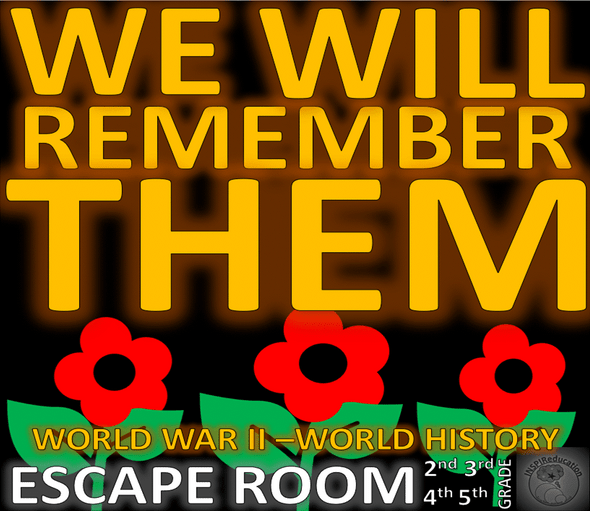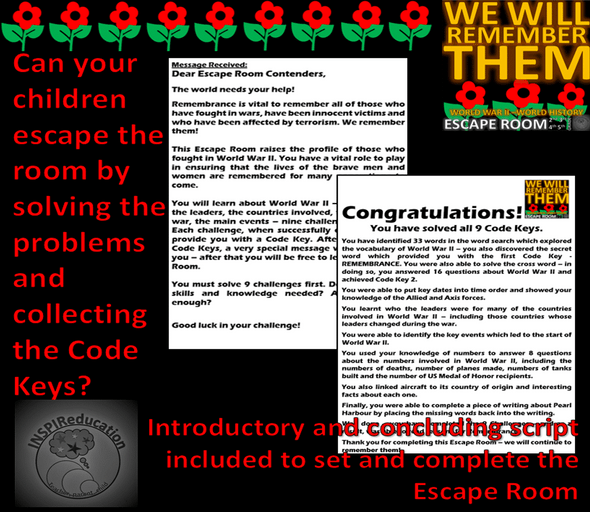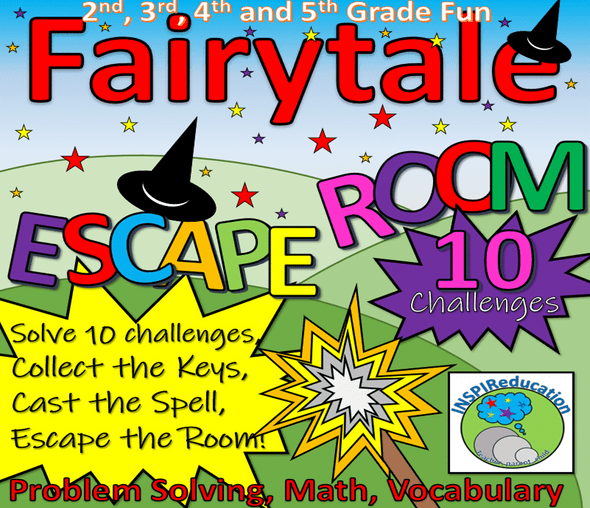Description
Using an Escape Room to develop curriculum knowledge is an exciting activity that will inspire learners from 3rd Grade to 7th Grade to learn about the causes, effects and consequences of World War 1.
The curriculum content of this Escape Room is linked to:
- World War One – Key events, consequences, facts and figures, involvement of countries
- Historical chronology,
- Historical cause and effect
- Literature – Cloze Procedure, Reading Skills, Comprehension
- Vocabulary development linked to World War 1
The aim of the Escape Room is to provide jeopardy for the children to work under pressure to solve 10 challenges to help raise the awareness of Remembrance of veterans and the innocent victims of war. The 10 Challenges within this Escape Room will support knowledge and understanding of the events, people and countries involved in World War I – but also end in a powerful message of Remembrance once all 10 Code Keys have been collected!
Before beginning, you will need to prepare the following:
- A copy of the Pupil Workbook (Code Key Booklet) for each group taking part in the Escape Room (included)
- A copy of the Answer Booklet for teacher use (included)
- Initial Starting Script sharing the problem to the children (included)
- Completion Script celebrating the completion of the challenge (included)
- Team Name Table Labels printed and placed on team tables (included)
- IT sources and research materials (if required by your students)
Children do not need prior knowledge of World War I to complete this Escape Room, however, the ability to have access to research resources will support the answers. This Escape Room is ideal as a review of learning to identify what the children have learnt and retained as a result of completing the study unit of World War I.
The activity begins by the teacher reading the Initial Message received. It clearly tells the children that they are required to help raise the understanding of why Remembrance is important. The way to do this is to successfully complete 10 Challenges – each one will provide a Code Key, enabling the children to move onto the next Challenge and so on until all 10 are completed.
After the 10th activity – the children will be able to read a powerful piece of Remembrance – their role in the Escape Room has been completed and the teacher can then read out the final celebratory message – contained within the Resources Pack.
Each activity focuses and builds the children’s knowledge of World War I and continues to reinforce the notion and importance of Remembrance:
The 10 activities are based on the following outcomes:
- Word Search to introduce 33 key words related World War I – ensuring that children develop a wide vocabulary when discussing key events, leaders and elements of World War I. There is a secret word for the children to find which is the Code Key to move to Challenge 2 (Poppies)
- Crossword to complete which introduces further important information to the children – there are 14 clues to solve.
- Timeline of key events leading up to and within the first month of World War I
- Allied Powers and Central Powers – Who was on which team?
- Leaders and their Countries
- Archduke Franz Ferdinand – Why was his death so influential in the start of World War 1?
- RMS Lusitania – Why was the sinking of this ship so vital to the achievements of the Allied forces in World War 1?
- World War 1 in numbers (multi-choice response questions)
- End of World War 1 Cloze Procedure
- End of Challenge Quiz – 9 Questions and Multi-choice answers.
When all 10 challenges are completed, and the children have gained the correct Code Keys from each activity, the children can then read the final piece of writing – REMEMBRANCE.
After this, the teacher can read the final communication detailing how the children have been able to help remember those people affected by war. At either the point of ending the Escape Room, or following the final message – it would be worth developing their understanding of Remembrance further to make the links between war, sacrifice and learning from actions and mistakes clear.
Setting up the Escape Room
1. Children should be split into groups of no more than four and be placed in their own workspace.
2. Access to IT and research materials should be provided to allow children to research answers to questions and review their own knowledge, as well as checking answers.
3. Each group should have a Code Key Booklet and decide on a team name
4. Read the Initial Message to the children to set the challenge in context. Discuss what this means, and what the activity entails.
5. Turn to Code Key 1. Agree with the children a set time to complete the problem in – this ensures that the children stay on task and maintains the Escape Room element of working under pressure.
6. At the end of the time, children should have filled in the Code Key in their booklet. The teacher can then check the accuracy of all the groups and talk through the responses the children should have.
7. Move on through the remaining challenges until all 9 have been completed.
8. For those groups who have been successful, they are then able to read the completed statement where they find out if they have escaped the Escape Room!
There are other ways of running Escape Room activities, for example, each activity could be set up on 10 tables and the children then move from table to table completing the activity. This would reduce the need for as many resources, and access to non-fiction sources and Internet Resources could then be targeted at specific Challenges.
The Escape Room should last for 2 hours.
Best wishes
INSPIReducation





























